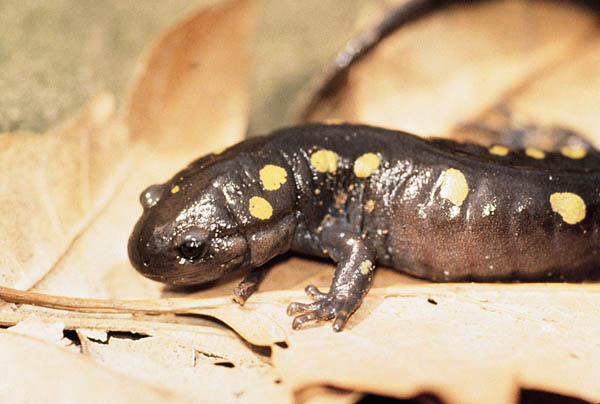 Global amphibian declines and extinctions spurred herpetologists to pay special attention to frogs, salamanders and caecilians in 2010. In Part 1 of this article, I reported on the discovery of several new species, and the re-discovery of a few that had not been seen for decades. Today we’ll look at interesting findings concerning a well-known salamander that houses algae in its cells and a rarely- seen species that lives for over 100 years.
Global amphibian declines and extinctions spurred herpetologists to pay special attention to frogs, salamanders and caecilians in 2010. In Part 1 of this article, I reported on the discovery of several new species, and the re-discovery of a few that had not been seen for decades. Today we’ll look at interesting findings concerning a well-known salamander that houses algae in its cells and a rarely- seen species that lives for over 100 years.
Algae in Salamander Cells
It’s long been known that algae growing within the egg masses of Spotted Salamanders, Ambystoma maculatum, provides oxygen to the embryos and utilizes their waste products. In 2010, however, Dalhousie University (Canada) biologists shocked the herp world by announcing that they had found living algae within Spotted Salamander cells, functioning as it does in the egg mass. This is the closest known association between a vertebrate and a plant, mimicking in some ways the relationship between algae and coral.
This discovery may have important implications for medical research. Since vertebrates typically destroy foreign bodies that attempt to live within cells, the salamanders must have a way to “turn off” the immune system. Research is also focusing on their unique abilities to regenerate complex structures such as limbs and tails.
Salamander Lives for Over a Century
Found only in subterranean streams in a few caves in southern Europe, the Olm, Proteus anguinus, is one of earth’s most unusual salamanders, and has fascinated biologists and area residents for centuries. Olms are blind, retain external gills, never see the light of day, do not mature until age 16, and reproduce by both laying eggs and bearing live young. Despite their very unique natural environments, Olms do quite well in zoos, often living into their 70’s.
 Due to the Olm’s rarity, researchers have maintained a breeding colony in a cave at St. Girons, France, since the 1952. A search of its records revealed that individual Olms have survived for over 100 years…double the lifespan of the previous record-holders, the Japanese Giant Salamander and the African Bullfrog. It is hoped that research into the basis of their longevity will be of benefit to those studying aging in humans.
Due to the Olm’s rarity, researchers have maintained a breeding colony in a cave at St. Girons, France, since the 1952. A search of its records revealed that individual Olms have survived for over 100 years…double the lifespan of the previous record-holders, the Japanese Giant Salamander and the African Bullfrog. It is hoped that research into the basis of their longevity will be of benefit to those studying aging in humans.
Further Reading
Algae and Salamander Eggs, an Odd Partnership
Video of Spotted Salamanders breeding in the wild
The Olm: history of the breeding colony mentioned above and interesting local folklore
 That Reptile Blog – Reptile, Amphibian and Exotic Pet Care and Information
That Reptile Blog – Reptile, Amphibian and Exotic Pet Care and Information



hey Frank! i’ve read about the first part. It’s really interesting. It’s in spanish, if it wouldn’t i would paste it here. Where do you get P. anguinus picture? there’re not many on the web
.
Hello Fernando, Frank Indiviglio here.
Nice to hear from you again; thanks for the kind words. The photo is from Wikipedia; check out the entry,. There are many good ones there, including one black phase animal. I’m putting the photo credits in the article now, missed that, thanks,
Please let me know if you need any further information. Good luck, enjoy and please keep me posted.
Best regards, Frank Indiviglio.